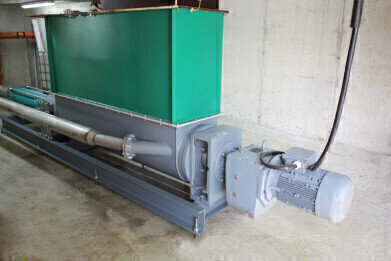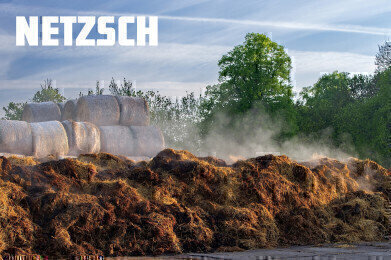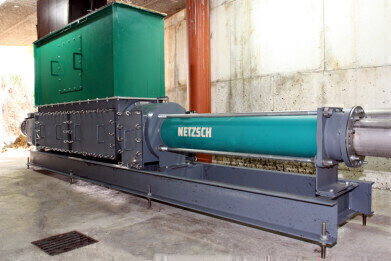Green energy
Operating small biogas plants efficiently: special feed and homogenisation technology saves power and substrate
Jun 28 2017
Following the large biogas boom in Germany in the years up to 2011, energy production using renewable raw materials now hardly seems to interest anyone. The number of plants has stagnated at around 9,000, whereas during the heyday of environmentally friendly technology some 1,500 bio-reactors came on stream in just one year. Reductions in subsidies are the reason for the turnaround, and above all changes in aid made by the amendment to the German Renewable Energies Act (EEG) of 2014 which now only provides maximum support for plants of up to 75 kW. This offer targets farmers who only recycle their own waste, in contrast to purely commercial biogas plant businesses. However, efficiency is questionable when it comes to these small amounts of energy, with the bio-reactors needing some power and heat themselves. To increase efficiency in this area and make small plants viable, use of special technology is advised: pulp feeding using special macerating and conveying systems. This enables substrate use to be reduced by up to 15% and power consumption by over 50%.
The core element of biogas production is biomass fermentation by specialised fermentation bacteria. The better these can work, the higher the gas yield is – which means the plant concept should be designed to create the ideal habitat for the microbial aides. As far as possible, this includes good pre-maceration of the substrates to create more contact areas for fermentation, thorough mixing of the substrate to ensure full distribution of the bacteria and consistent temperature control of the fermenter. However, the usual biomass mix of silage, plant cuttings, dry components such as chicken droppings and manure offers a rather poor basis for this: the inhomogeneous composition not only limits fermentation, but also makes it more difficult to feed the fermenter. Screw conveyors are therefore often used. These can indeed transport any kind of material, but they are also susceptible to breakdowns, cumbersome and dirty.
Smooth conveyance of fermentation substrate
Pulp feeding represents an alternative to this. It involves the substrate already being homogenised, mixed and inoculated with fermentation bacteria before the fermenter. This produces a mixture that flows well and can easily be conveyed through a pipe, enabling a higher yield with lower costs. NETZSCH Pumpen & Systeme GmbH has developed the NEMO® B.Max® mixing pump specially for this application. This is based on proven progressing cavity pump technology which involves a helix rotor rotating in a stator that is geometrically adapted to it. In the process, conveying chambers with the same shape open up in which the medium is conveyed smoothly from the inlet to the discharge side, irrespective of its consistency. This also has the advantage for the biogas sector of being able to handle varying substrate compositions easily. In addition, this process involves hardly any pulsation or shear forces, so that the phases of the medium do not separate and the bacteria it contains are not damaged either.
The micro-organisms are added to the substrate via recirculated substances from the fermenter. In this way, the fluidity of the medium is increased and at the same time the fermentation process is already initiated in the pump. The biomass required for this is brought in via a wide, rectangular feed hopper which prevents clogging thanks to its conical shape. Where there is particularly lumpy, fibrous substrate with a high dry matter content, an aBP® bridge breaker can also be incorporated which prevents bridging on the sidewalls by means of rotating wheels.
Starting homogenisation in the pump saves power and substrate
The material falls out of the hopper into the mixing chamber, the core element of the B.Max® pump. Here, a screw conveyor on the coupling rod ensures thorough mixing of the various components of the substrate, while it is being conveyed to the actual pump area. This process is supported by an optimally positioned feed tube through which manure or recirculated substances are fed in opposite directions, thus increasing the mixing efficiency, as well as by the special pitch and segmentation of the mixing screw. Its special design conveys more medium to the progressing cavity pump than the latter can transport away, thus producing a controlled backflow which ensures additional turbulences. These three properties – mixing screw, fluid feed in opposite directions and backflow – enable a homogeneous, fermentable substrate pulp to already be produced in the pump and this offers the fermentation bacteria a suitable working environment. At the same time, the technology means there is no need for a separate mash tun and also enables conveyance of the biomass over longer distances and gradients allowing more flexibility in plant design.
This particularly applies when feeding the fermenter, because transport via a pipe enables feeding into the lower area of the septic tank. This produces quite significant movement in the fermenting substrate, which in turn improves natural convection and minimises the formation of scum layers. In combination with the substrate, which is pulpy anyway, it means less frequent use of the stirring unit is needed and there is better heat circulation through the whole fermenter. A Bavarian bio-energy producer was able to reduce their stirring unit operating times by 40 percent and substrate use by eight percent with the same yield. In general, the experts at NETZSCH reckon on a stirring requirement that is less than half as high as a dry feed system, which is reflected in significantly lower power costs, and on a biomass saving of around 15 percent – two vital factors for biogas plant efficiency.
In order to keep maintenance costs low as well, the B.Max® pump has a very robust design and is specifically tailored to the application, for example by means of a coated or hardened feed hopper. An appropriate selection of materials for the rotor and stator also ensures the longest possible service lives are achieved. In addition, the pump has generously sized inspection openings, which means it does not need to be dismantled for any cleaning or inspection work, and it can be fitted with dry running and over pressure protection systems if necessary. This enables up to 70 m³/h of substrate to be transported at up to 48 bar and this can be freely regulated via the speed. The design is for such high pressures, whereas media are normally only conveyed at around 1 to 3 bar, so this further increases service life.
Pre-maceration of difficult materials
For even greater operational reliability – especially where it is intended to recycle very coarse basic materials – it is advisable to connect a macerator before the pump. This allows impurities such as stones to be removed and plant remains with long fibres to be chopped up before they can cause damage or clogging. Downtimes, which not only worsen the performance record, but can also lead to the substrate of the fermenter tipping over in extreme cases, can be reliably avoided by this. NETZSCH developed the M-Ovas® cutting plate macerator for this, which comprises a knife head with hard metal knives and an edge made of hardened steel that can be used on both sides.
The rigid cutting unit with self-adjusting cutting mechanism achieves a high cutting efficiency, with the capacity to process up to 300 m³ per hour with a dry matter content of up to twelve percent. In the process, an integrated flywheel reduces the drive power required and so saves energy. At the same time, the rigid design allows a smaller distance between the edge and shear plate, which reduces wear. For any cleaning or maintenance work that may nevertheless arise, the wide housing cover with the integrated cutting unit can very easily be removed with the aid of gas struts. If you expect there to be very inhomogeneous media or media whose size or consistency fluctuates a lot, a twin shaft macerator can also be fitted instead. This will even handle wood or plastic with its knife shafts rotating in opposite directions.
Robust rotary lobe pump for high flow rates
In addition to actual substrate preparation and feeding, NETZSCH also offers solutions for other applications involved in biogas production. The TORNADO® T.Envi® rotary lobe pump was for instance created for tasks involving high conveyance volumes, such as emptying manure barrels or substrate agitation. Its large conveying chamber and wide free ball passage mean it is to a large extent immune from clogging and can transport up to 1,000 m³/h, depending on the model. The T2 design offers the best space-performance ratio here, because in this case the motor is flange-mounted above the conveying chamber and a synchronised belt drive transmits the torque to the shafts. This means the compact pump fits into the tightest spaces as well. Furthermore, this drive version is characterised by being extremely robust and maintenance friendly: the belt does not need to be lubricated, is resistant to malfunctions and can be very easily replaced if necessary.
Overall, these different systems tailored for biogas production enable very high plant efficiency, while at the same time ensuring low costs and little effort. For farmers, who are particularly targeted by the current subsidies for small plants, this provides a real opportunity to use their operational waste sensibly and to produce environmentally friendly energy from it. In particular, pulp feeding promises fast payback, so that bioreactors on a smaller scale can definitely develop into a viable profit-making option for German agriculture once again – and therefore support the switch to renewable energies over the long term.
Events
May 18 2025 Algiers, Algeria
23rd International Water Management Exhibition
May 20 2025 Prague, Czech Republic
Singapore International Water Week Spotlight 2025
Jun 23 2025 Singapore
Jun 25 2025 Sao Paulo, Brasil
Jul 02 2025 Bangkok, Thailand





















